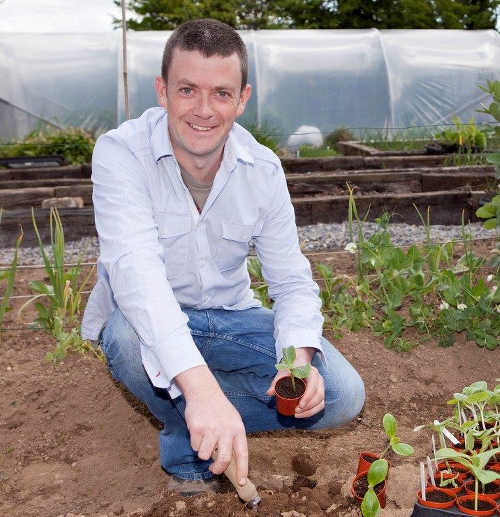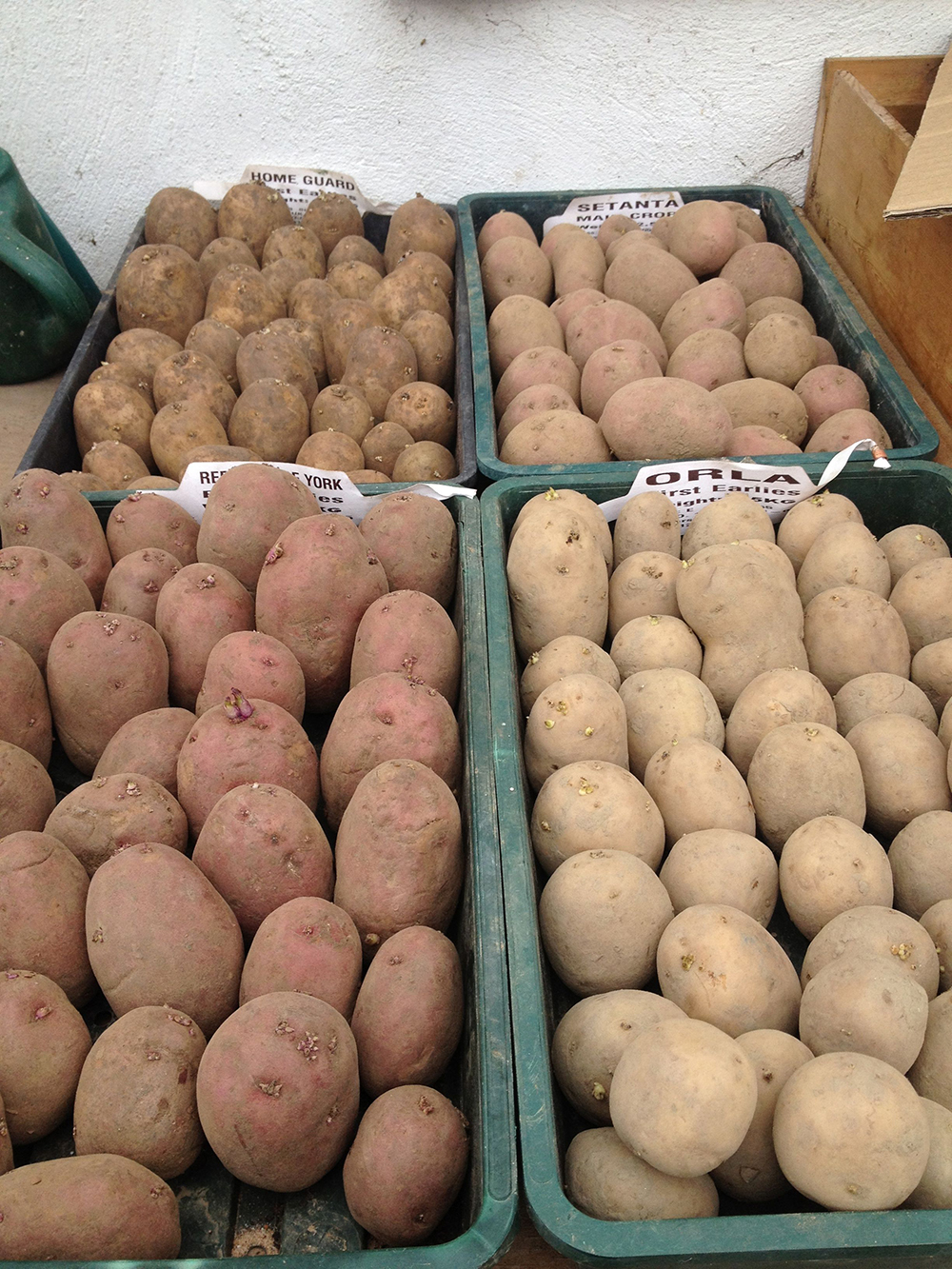Grow it Yourself
 Most people sow their early potatoes outside in the vegetable patch in March, but if you have a polytunnel or greenhouse you can get started right now for a super early crop (May). Some years ago I went on a course with Jim Cronin over at his smallholding in Co Clare, and he outlined this method, which creates very deep beds and gives you an abundant crop.
Most people sow their early potatoes outside in the vegetable patch in March, but if you have a polytunnel or greenhouse you can get started right now for a super early crop (May). Some years ago I went on a course with Jim Cronin over at his smallholding in Co Clare, and he outlined this method, which creates very deep beds and gives you an abundant crop.
Cultivate the soil in the bed in the tunnel where you are going to sow spuds and make it loose. Take the soil from the bed (down to the subsoil) and put it out on to the path. Put your seed potatoes on to the subsoil at 10 inch spacing. On top of each potato put a little bit of soil. Put 15 inches of farmyard manure on top of the spuds. The little bit of soil stops the manure from burning the seed potatoes. The manure can be fresh or composted. Then put the soil from the path back on top of the manure. It is the depth of manure and soil on top of the seed that encourages a long stalk and therefore lots and lots of lovely spuds.
Put some fleece on top to protect from cold weather. Take fleece off when potato plants appear but put back on at nighttime where frost is a risk. Hoe occasionally to prevent weeds from taking hold, until the plants produce a canopy of leaves, which will prevent weeds. Do not water until some of the plants start to flower – probably April. There is enough moisture in the air in the tunnel in Feb and March and if you water too early you will get tall, leafy plants but few spuds. Start to look for spuds from early May. Cut stems down to 2 inches in July (if you still have any spuds left by then), which will allow you to leave them in the ground for longer.
The Basics – Jobs for the Month Ahead
 To Do
To Do
If you have not already done so order/buy your seeds, spuds and onion sets. “Chit” or sprout seed potatoes – put them in a container (e.g. used egg carton or empty seed tray) and leave them in a bright warm place. Check the pH of your soil – you can buy a soil pH testing kit in any garden centre. Lime your soil now if required (to reduce acidity in very acid soils), particularly important in your brassica bed.
Sow
Later this month we can, finally, sow some seeds. On a sunny windowsill indoors, in a heated greenhouse or on a heating mat: sow celery, globe artichokes, celeriac, leeks, onions, lettuce, tomatoes, peas, aubergines, peppers/chilli-peppers. For polytunnel or greenhouse: beetroot, carrots, leeks, lettuce, radish. Outside: Weather permitting you can try planting out broadbeans and early pea varieties.
Harvest
You could still be harvesting carrots, leeks, celeriac, Winter cabbage and cauliflowers, Brussels sprouts, spinach and kale.
Recipe of the Week – Mick’s Made-up Sausage and Beer Stew
Last night I was searching for ideas to make dinner and all I had in the fridge was a tray of sausages. Though I was tempted to go for a simple plate of sausage, eggs and chips, I had some veg in the basket from a harvest last weekend, and decided to concoct some class of a stew. It was surprisingly delicious, and warming on a cold January night. I would generally pair sausages with cider in a stew, but it being dry January all I had in the fridge was a bottle of non-alcoholic lager! Never mind, it seemed to work. Don’t worry too much about sticking to the veg ingredients – you could use celery instead of celeriac or swede instead of squash etc. Be adventurous.
Serves 4
Ingredients
• 6-8 good quality dinner sausages
• 2 onions, diced
• 1 leek, chopped finely
• 4 cloves garlic, peeled and diced
• Half a celeriac, peeled and diced
• 2 large carrots, diced
• ¼ of a squash or pumpkin, peeled and chopped in to large chunks
• Small bottle of beer
• Tin of tomatoes or 2 tbs tomato puree
• 500ml beef or chicken stock
• 1 tbs mustard (I used Dijon)
• 2 tbs chopped herbs (parlsey, rosemary and thyme)
• 1 bay leaf
Directions:
Heat a small amount of oil in a frying pan. Cut the sausages in to chunks and fry them for a minute or so on each side until browned. Remove from the pan and set aside on a plate. In the same frying pan, fry the onions, garlic, leeks, carrots and celeriac on a gentle heat for about 10 minutes (until soft). Transfer to a heavy saucepan or casserole.
Pour the bottle of beer in to the frying pan to deglaze the pan, scraping any nice brown bits off the pan with a wooden spatula. Bring to the boil and let it simmer for about 10 minutes to reduce down a little. Add it to your saucepan with the veg, and also add the stock, tomatoes, herbs and mustard. Bring to the boil and then add the squash or pumpkin.
Cook for 15 minutes with the lid on. Add the sausages back to the saucepan and cook for another 15 minutes. Taste and season with salt and pepper. Check the consistency - leave to simmer for another 10 minutes if it needs to be thickened or add a little boiling water if it’s too thick.
Serve with crusty bread or baked potatoes.
Michael Kelly is an author, broadcaster and founder of GIY.
© GIY Ireland 2019 – all rights reserved.





There are currently no comments
Leave a comment
Not a member? Register for your free membership now!
Or leave a comment by logging in with: